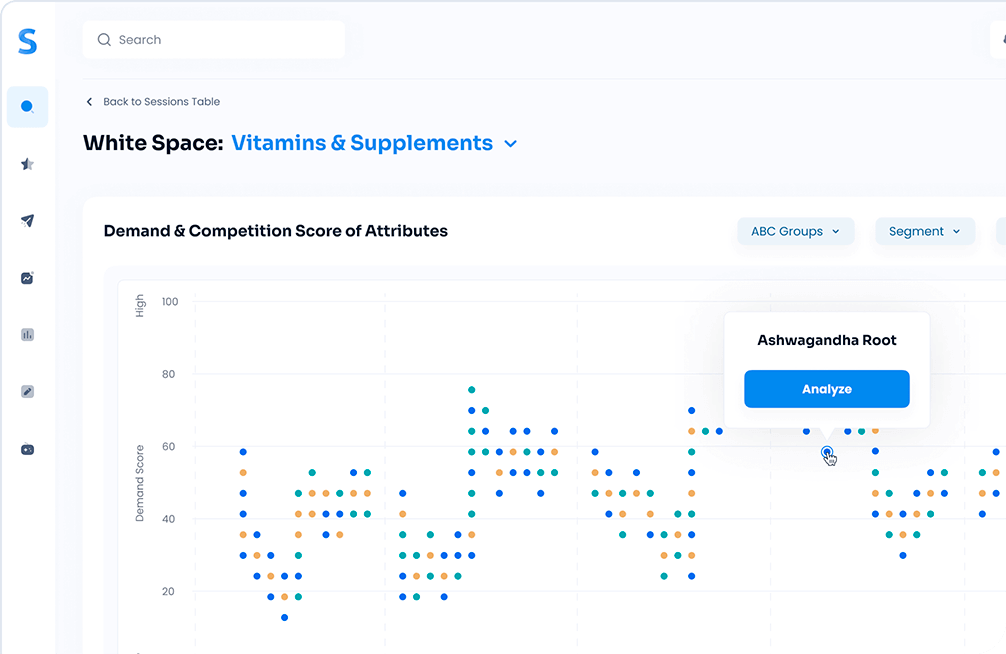In recent years, the culinary world has witnessed an unmistakable surge in the popularity of plant-based meats and cheeses. Health enthusiasts, environmental advocates, and ethically conscious consumers are progressively turning their attention, and appetites, toward more sustainable and compassionate food choices. This shift isn’t merely a fleeting diet fad; it’s a profound, value-driven move toward products that promise well-being, planetary stewardship, and ethical consumption. For stakeholders – such as food producers, retailers, and culinary innovators – tapping into this burgeoning market necessitates a nuanced understanding of consumer desires and purchasing drivers. Decoding these preferences isn’t just a strategic imperative; it’s pivotal to crafting offerings that resonate with the values and tastes of today’s discerning consumers. In the unfolding sections, we delve into the trajectory of plant-based foods, exploring past patterns, present innovations, and potential future developments, all through the lens of consumer preferences and market dynamics.
Ensuring a smooth transition to the historical context, it’s noteworthy that the present enthusiasm for plant-based products has its roots deeply entwined with past consumer behavior and market evolutions. As we step back in time, the journey of plant-based meats and cheeses unveils a captivating tale of innovation, adaptation, and the steady rise of conscious consumerism.
Historical Context

Peering through the lens of time, the evolution of plant-based meats and cheeses is not merely a tale of culinary innovation but also a reflection of societal shifts toward conscious consumption. Tracing back a few decades, vegetarianism and, subsequently, veganism carved out their niches primarily in subcultures concerned with animal welfare and environmental sustainability. Initially, alternatives to meat and dairy were sparse and often lacked the appeal and palatability of their traditional counterparts. Consumers, thus, were limited in choice and often had to compromise on taste and texture in the name of ethics and sustainability.
As technological and culinary advancements melded, the past decade heralded a new era for plant-based foods. A wave of startups and established food giants began investing in developing meat and cheese alternatives that didn’t just mimic, but in some cases, rivaled the sensory experience offered by animal-derived products. Consumer preferences have steadily tilted towards these innovative offerings, not only due to a surge in environmental and health awareness but also owing to the enhanced quality and availability of such products. It is this marriage of values and appetites that steered the market toward its present state, birthing products that stand tall on both ethical and sensory grounds.
The landscape now, enriched and varied, extends an assortment of alternatives that cater to a broad spectrum of tastes and dietary requirements. As we maneuver through the current market trends, it’s pivotal to realize that these historical shifts have laid the foundation for the intricate tapestry of consumer preferences and market offerings witnessed today.
Current Market Trends

Emerging from the rich history of plant-based culinary development, the present marketplace showcases a vibrant array of offerings that ingeniously marry taste with ethics. This proliferation isn’t merely a testament to the increased demand but a reflection of deep-seated shifts in consumer lifestyle and values. Venturing into the contemporary realm of plant-based meats and cheeses, it’s imperative to navigate the trends, spotlight key players, and recognize innovations that shape the current consumer landscape.
A robust trend firmly establishing its roots is the rise of gourmet plant-based products. Consumers are no longer content with merely replicating traditional meat and cheese; they’re seeking unique flavors, textures, and culinary experiences. Brands like Impossible Foods and Beyond Meat have not only captured attention but have also forged partnerships with fast-food chains, weaving plant-based options into mainstream culinary culture. Meanwhile, companies like Miyoko’s Kitchen are redefining plant-based cheeses, crafting products that not only mimic but celebrate the rich, nuanced flavors found in traditional dairy.
In the technological arena, advancements are equally fascinating. Cell-based meats, although not plant-based, are capturing interest as they offer meat without the ethical and environmental drawbacks. Simultaneously, innovations in fermenting plant proteins have brought forth products that boast flavors and textures previously unattainable in vegan offerings. Fermentation technologies and precision fermentation, in particular, enable brands to create proteins and ingredients that significantly elevate the sensory profile of plant-based products.
The current market, hence, is not merely responding to a demand for alternatives; it’s innovatively expanding and enhancing the very definition of what plant-based can offer. A rich tapestry of tastes, values, and technologies intertwines to present consumers with choices that extend beyond mere substitution. Engaging with these trends requires an intimate understanding of consumer desires, which will be our focus as we delve into the intricate web of consumer preferences in the upcoming section.
Consumer Preferences

Navigating through the lush landscape of the current plant-based market, the motivations driving consumer choices begin to weave a compelling narrative, offering a clear picture of the priorities, desires, and expectations that mold purchasing behaviors. In the complex mosaic of factors that influence consumer selections within the plant-based meats and cheeses sphere, elements such as taste, price, nutritional value, and brand ethics are paramount.
Taste, the intrinsic allure of any food product, is paramount, with brands striving to satisfy palates by crafting products that don’t just mimic but elevate the traditional sensory experiences associated with meats and cheeses. Price and affordability play crucial roles in democratizing plant-based choices, rendering them accessible and appealing to a broader audience, while nutritional value becomes pivotal for health-conscious consumers. Not to be overshadowed, brand ethics too cast a significant impact, with consumers increasingly aligning their purchases with their values.
Insightful data from Simporter underscores a vital trend: the elevation of ecological considerations in consumer preferences. For both Plant-Based Meat and Plant-Based Cheese, ecological needs such as no waste, reduced water usage, eco-friendliness, cruelty-free practices, and organic production are not mere bonuses but are emerging as principal consumer demands. A stark alignment with ecological imperatives is not only prevalent but is becoming deeply intertwined with purchasing choices within these categories.
Demographic observations spotlight the younger generations – Millennials and Gen Z – as particularly fervent advocates of plant-based eating, often tethering their dietary choices closely with their ethical, environmental, and health concerns. Yet, the appeal of plant-based is transcending age brackets, expanding into a wider demographic as the industry innovatively addresses varied consumer needs and preferences.
As we glance towards the horizon, acknowledging these preferences becomes pivotal in identifying and navigating the challenges and opportunities that lay embedded within the plant-based meat and cheese sectors, a dynamic exploration we undertake in the following section.
Challenges and Opportunities

With a foundation steeped in understanding the subtle and diverse nuances of consumer preferences, we pivot towards addressing the evident and latent challenges experienced by consumers and concurrently, the manifold opportunities these open up for enterprises and innovators in the plant-based arena.
One palpable challenge that echoes in the aisles of grocery stores is the price point of plant-based meats and cheeses. Often pegged at a premium compared to their animal-derived counterparts, affordability becomes a hurdle for many consumers, especially those eager to integrate plant-based options into their regular diet. Accessibility, too, particularly in certain geographical locations, impedes the smooth transition for consumers towards plant-based alternatives.
However, within these challenges, lies a fertile ground of opportunities for businesses. Addressing price sensitivity not only involves examining production and distribution costs but also exploring avenues like localized sourcing and optimizing supply chains. An investment in innovation, aimed at creating cost-efficient products without compromising quality, can disrupt the market, delivering affordability alongside superior taste and texture.
Moreover, enhancing accessibility extends beyond merely increasing physical availability. It involves fostering partnerships, perhaps with local producers or distributors, to weave a robust network that ensures plant-based products are not just physically available, but are also culturally and economically accessible to a diverse consumer base.
Innovation should not only be confined to the product but should permeate every facet of the business model – from production, supply chain management, to marketing – to holistically address the challenges faced by consumers and to effectively leverage the burgeoning opportunities presented by the expanding plant-based market.
The insights derived from comprehending both the historical and current landscapes, as well as consumer preferences, weave into the narrative of future projections, a realm we shall explore in our ensuing discussion.
Future Projections

The horizon of the plant-based meat and cheese sectors holds a panorama rich with possibilities, beckoning stakeholders with a plethora of opportunities intricately interwoven with potential challenges. The crux of this future leans heavily into innovative evolution and judicious adaption of market players to the undulating waves of consumer preferences and industry advancements.
In future trajectories, the plant-based market is poised to burgeon beyond its current boundaries, catapulted by advancements in food technology that promise enhancements in taste, texture, and nutritional profile. Coupled with an increasingly aware consumer base, this trajectory will see an uptick in demand for more diversified and nuanced plant-based offerings. An insatiable curiosity for culinary experiences coupled with steadfast ecological and ethical convictions will spearhead innovations in flavors, formats, and perhaps, the integration of novel plant sources.
Moreover, the amalgamation of technology and data analytics, as championed by platforms like Simporter, will streamline product development cycles, optimize marketing strategies, and provide real-time insights into evolving consumer behaviors and preferences. This integration will not only fortify brands with informed decision-making capabilities but also scaffold the creation of products that resonate authentically with consumer needs and wants.
Stakeholders, ranging from product developers, marketers, to supply chain managers, will navigate through this evolving landscape, calibrating their strategies to not only anticipate but also shape consumer behaviors and market trends. With this forward momentum, it is imperative to approach the future with a lens that discerns opportunities amidst challenges and leverages data-driven strategies to curate offerings that are not only in sync with consumer preferences but also sustainable and innovative.
As we unfold this future tapestry, let’s delve into the next section, crafting recommendations that align with these future projections, ensuring a strategic, responsive, and innovative approach in navigating the plant-based market’s potentialities.
Recommendations

In the pulsating realm of the plant-based sector, stakeholders are poised at a critical juncture where judicious, data-driven decisions can steer the course towards sustainable growth and enhanced consumer satisfaction. In this final segment, let’s explore actionable recommendations that intertwine consumer preferences with coherent, strategic planning, ensuring that the sector does not merely grow, but thrives.
Engage with Authenticity: Understanding and aligning with consumer values is paramount. Be it through embracing sustainability in production or ensuring ethical practices, brands should embody the values they espouse, genuinely mirroring the eco-conscious and ethical aspirations of their consumer base.
Leverage Technology and Data: Utilize platforms like Simporter to harness the power of AI in capturing and analyzing consumer preferences and market trends. This enables not only a pulse on the present, but a predictive lens into future trends, ensuring preparedness and proactive strategy formulation.
Diversify and Innovate: Foster a culture of innovation that explores diverse plant sources, culinary techniques, and product formats. From leveraging uncommon plants to exploring varied culinary formats, innovation should permeate every facet of product development.
Craft Accessibility: Seek to demolish barriers to accessibility, both in terms of price and availability. This may involve scrutinizing and reconfiguring supply chains, exploring localized sourcing, or adopting innovative production techniques to manage costs without compromising quality.
Communicate Effectively: Transparent, authentic, and engaging communication that not only informs but also resonates with consumers will enhance brand loyalty and advocacy. This includes harnessing digital platforms to narrate stories that align with consumer values and aspirations.
In amalgamating these recommendations with the insights and projections gleaned from preceding sections, stakeholders can strategically navigate through the dynamic plant-based sector. This intertwines an understanding of historical, current, and projected futures with actionable strategies, ensuring the plant-based meat and cheese market not only burgeons but also remains resilient, sustainable, and deeply rooted in consumer preferences.
Conclusion

An exploration through the variegated landscape of plant-based meats and cheeses has offered a panoramic view, unveiling the sector’s evolution, the prevailing market tendencies, and the meticulous consumer preferences guided notably by values and ethics. The journey, richly adorned with historical context and futuristic projections, emphasizes not only the viability but the imminent necessity for an alignment between stakeholder strategies and consumer desires.
Engagement, authenticity, and strategic innovation stand out as beacons, lighting the path toward a future where plant-based consumption is not a mere alternative but a mainstream, universally accessible choice. Employing AI platforms like Simporter, stakeholders can adeptly navigate through the complex matrices of market trends, consumer needs, and product innovation, ensuring that every strategic step is deeply rooted in data and insights.
Let this exploration serve as both an inspiration and a gentle nudge for stakeholders to immerse themselves in a dialogical relationship with consumers, fostering a future where the plant-based sector does not just grow in isolation but flourishes in a symbiotic relationship with consumer needs, preferences, and values. Together, let’s sculpt a future where the palate of offerings in plant-based meats and cheeses is as diverse, accessible, and delightful as the consumers it seeks to enchant.
This is not merely a conclusion but an initiation into a future crafted in unison between consumers and producers, narrating a tale where ethical, environmental, and health-conscious choices prevail.









